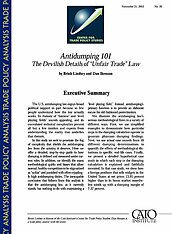The U.S. antidumping law enjoys broad political support in part because so few people understand how the law actually works. Its rhetoric of “fairness” and “level playing fields” sounds appealing, and its convoluted technical complexities prevent all but a few insiders and experts from understanding the reality that underlies that rhetoric.
In this study we seek to penetrate the fog of complexity that shields the antidumping law from the scrutiny it deserves. Here we offer a detailed, step-by-step guide to how dumping is defined and measured under current rules. In addition, we identify the many methodological quirks and biases that allow normal, healthy competition to be stigmatized as “unfair” and punished with often cripplingly high antidumping duties. The inescapable conclusion that follows from this analysis is that the antidumping law, as it currently stands, has nothing to do with maintaining a “level playing field.” Instead, antidumping’s primary function is to provide an elaborate excuse for old-fashioned protectionism.
We illustrate the antidumping law’s serious methodological flaws in a variety of different ways. First, we use simplified examples to illustrate how particular steps in the dumping calculation operate to generate phantom dumping findings. Next, we use actual case records from 18 different dumping determinations to quantify the effects of methodological distortions in specific, real-life cases. Finally, we present a detailed hypothetical case study in which each step in the dumping calculation is explained and faithfully recreated. In that case study, we show how a foreign producer that sells widgets in the United States at prices 13.96 percent higher than in its home market nonetheless winds up with a dumping margin of 7.37 percent.

This work is licensed under a Creative Commons Attribution-NonCommercial-ShareAlike 4.0 International License.


